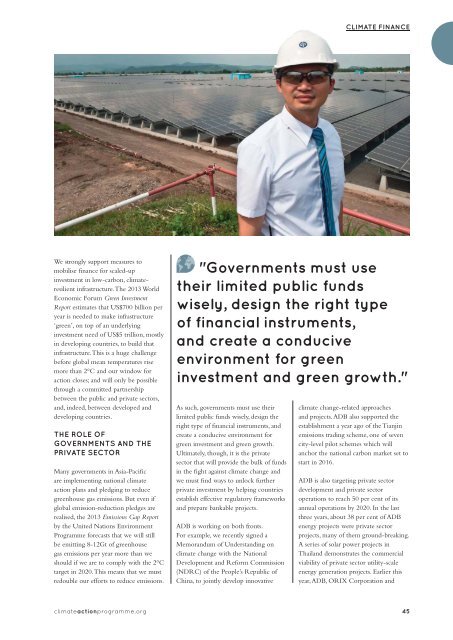Climate Action 2014-2015
Create successful ePaper yourself
Turn your PDF publications into a flip-book with our unique Google optimized e-Paper software.
CLIMATE FINANCE<br />
We strongly support measures to<br />
mobilise finance for scaled-up<br />
investment in low-carbon, climateresilient<br />
infrastructure. The 2013 World<br />
Economic Forum Green Investment<br />
Report estimates that US$700 billion per<br />
year is needed to make infrastructure<br />
‘green’, on top of an underlying<br />
investment need of US$5 trillion, mostly<br />
in developing countries, to build that<br />
infrastructure. This is a huge challenge<br />
before global mean temperatures rise<br />
more than 2°C and our window for<br />
action closes; and will only be possible<br />
through a committed partnership<br />
between the public and private sectors,<br />
and, indeed, between developed and<br />
developing countries.<br />
THE ROLE OF<br />
GOVERNMENTS AND THE<br />
PRIVATE SECTOR<br />
Many governments in Asia-Pacific<br />
are implementing national climate<br />
action plans and pledging to reduce<br />
greenhouse gas emissions. But even if<br />
global emission-reduction pledges are<br />
realised, the 2013 Emissions Gap Report<br />
by the United Nations Environment<br />
Programme forecasts that we will still<br />
be emitting 8-12Gt of greenhouse<br />
gas emissions per year more than we<br />
should if we are to comply with the 2°C<br />
target in 2020. This means that we must<br />
redouble our efforts to reduce emissions.<br />
"Governments must use<br />
their limited public funds<br />
wisely, design the right type<br />
of financial instruments,<br />
and create a conducive<br />
environment for green<br />
investment and green growth."<br />
As such, governments must use their<br />
limited public funds wisely, design the<br />
right type of financial instruments, and<br />
create a conducive environment for<br />
green investment and green growth.<br />
Ultimately, though, it is the private<br />
sector that will provide the bulk of funds<br />
in the fight against climate change and<br />
we must find ways to unlock further<br />
private investment by helping countries<br />
establish effective regulatory frameworks<br />
and prepare bankable projects.<br />
ADB is working on both fronts.<br />
For example, we recently signed a<br />
Memorandum of Understanding on<br />
climate change with the National<br />
Development and Reform Commission<br />
(NDRC) of the People’s Republic of<br />
China, to jointly develop innovative<br />
climate change-related approaches<br />
and projects. ADB also supported the<br />
establishment a year ago of the Tianjin<br />
emissions trading scheme, one of seven<br />
city-level pilot schemes which will<br />
anchor the national carbon market set to<br />
start in 2016.<br />
ADB is also targeting private sector<br />
development and private sector<br />
operations to reach 50 per cent of its<br />
annual operations by 2020. In the last<br />
three years, about 38 per cent of ADB<br />
energy projects were private sector<br />
projects, many of them ground-breaking.<br />
A series of solar power projects in<br />
Thailand demonstrates the commercial<br />
viability of private sector utility-scale<br />
energy generation projects. Earlier this<br />
year, ADB, ORIX Corporation and<br />
climateactionprogramme.org 45












